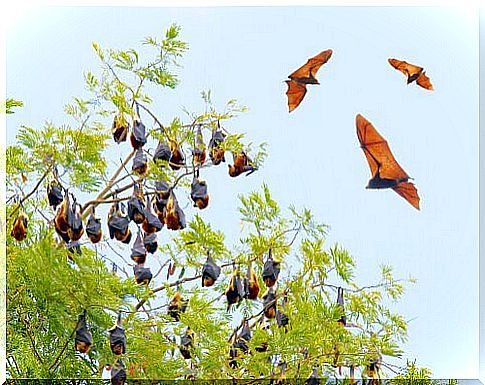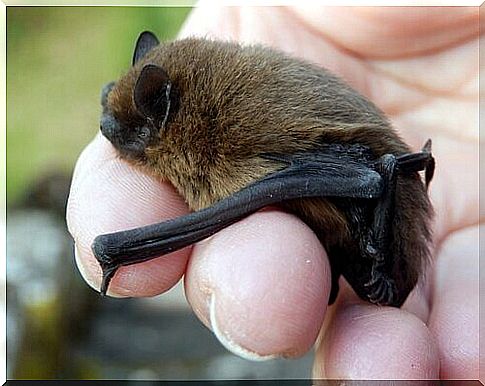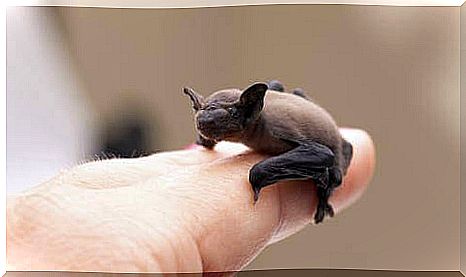5 Species Of Bats

The bats are the only mammals that can fly. Thanks to this unique feature they have managed to settle in much of the planet. Despite the superstitions surrounding them, almost all of them feed on fruit or insects. We invite you to discover, with us, five truly amazing species of bats .
Bat species: general characteristics
Bats are the second largest family in the animal kingdom, preceded only by rodents. There are an estimated 1,200 different subspecies of these flying mammals, although the number is expected to grow as new varieties continue to be discovered.
Only at the poles, north and south, this living being has failed to establish itself. The external environment has helped to stimulate changes that make each species different, based on the reference habitat . These animals have evolved very differently and there are even very small bats, weighing only a few grams. But let’s get to know the most representative ones together:
1. Common bat
This is, among the bat species in Europe, the smallest. It is just six centimeters long and has a wingspan of around 20-25 centimeters. It has a brown or gray color, sometimes almost black. The belly is of a lighter shade.

These mammals have small ears and their noses are also particularly short. They hibernate at the end of autumn and awaken with the arrival of spring. They live in large groups, both during wakefulness and throughout the winter.
This type of bat is present throughout the Italian territory, including the islands: these are small specimens that can be seen at sunset in the city or in rural areas. They eat small insects such as beetles or mosquitoes.
2. Golden-headed flying fox
Unlike the previous one, the golden-headed flying fox is one of the largest bat species in the world. It feeds only on fruit and sucks nectar from flowers, so it plays an important role in the ecosystem, in terms of pollination.

It does not use the echolocation system , but lets itself be guided by sight and smell. Unlike many other bat species, whose blurry vision allows them to distinguish dark or light shades.
As the name suggests, its muzzle resembles that of a fox. It has a long, sharp nose, large eyes compared to other specimens of its species, and straight triangular ears. Also, as you can see from the image above, it sports a distinctive reddish fur.
It lives in some islands of Oceania, on the Malay peninsula, between the Philippines, Sumatra, Borneo … It is not a species considered endangered, even if there is some concern about the decrease of native colonies. Scholars, however, are closely following the evolution of the situation.
3. Vampire Bat
Within this suborder, only three species feed on blood alone, despite legends and myths that refer to the famous Dracula written by Bram Stoker in 1897. From a morphological point of view, they differ from the frugivorous “cousins” in having a flattened and round muzzle, as well as pointed ears as long as the head.

To be able to feed on blood, they are equipped with an infrared thermoreception system that can recognize organisms that contain blood and hear the slow breathing of sleeping animals. They also know where the arteries are located, which are easier to access, and choose the right time to get close to their victim.
Unlike other bats, they are nocturnal animals and only come out when it is completely dark. Their prey is usually cattle or poultry; they never attack humans.
These three species are distributed in America and can only be found in parts of Mexico, Chile, Argentina and Brazil. The greatest danger to humans is the transmission of parasites or viruses such as rabies, although this type of contagion is very rare.
4. Bumblebee bat
Also known as a butterfly bat , this animal’s most distinctive feature is its nose, which resembles that of a pig. Here the differences end, as this bat is much smaller than any other “cousin”: it weighs only two grams and is considered one of the smallest mammals in existence.

It lives in western Thailand and parts of Burma in very humid areas, such as in caves near the banks of rivers. It is considered endangered.
5. Southern winged bat
It is another species of bat very widespread throughout Europe and, obviously, also present in Italy. However, its habitat includes agricultural and rural areas, Mediterranean woods and holm oaks, never higher than 2,000 meters above sea level.

As its name indicates, it has extraordinarily long ears and, when resting, it collects them behind its head. The ears are so large that they can double the size of the head. Its body is of medium size : between three and six centimeters in length and almost 25 in wingspan. Therefore, even in flight the two ears are easily distinguishable.
Bats have been the protagonists of macabre legends and stories of terror for centuries. But nothing is further from reality. The vast majority of them eat fruit or insects and are harmless to humans. Some perform a very useful function for the environment, such as pollinating plants and flowers or controlling pests.









